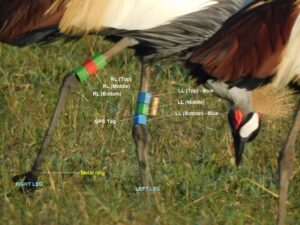February 2nd – 2.2.22 – is World Wetlands Day. It’s the anniversary of the Convention on Wetlands, adopted as an international treaty in 1971 in Ramsar, Iran.
Wetlands host birds, fish, amphibians, reptiles, mammals, insects, plants and microorganisms, providing food, shelter and breeding grounds. The seasonal wetlands of Dakatcha woodland, for instance, are the known breeding grounds of the Clarke’s (Kilifi) Weaver, a threatened bird found only in Kilifi County. Kingwal swamp in Nandi hills is a breeding site for the rare Sitatunga antelope.
Wetlands provide essential ecosystem services and support the livelihoods of millions of communities. Global recognition of the conservation value of the Tana River Delta confirms the significance of the ecosystem services it provides. This vast wetland system provides intangible environmental services, including: regulation of the hydrological cycle, moderation of the climate, protection of soil from erosion, stabilization of the shoreline and reduction of the impact of storm surges. The Delta significantly contributes to the livelihoods of farming, herding and fishing communities, cultural and recreational activities, and supports economic development for Tana River and Lamu Counties and the nation.
Despite the critical functions they provide, wetlands are continually under threat. Yala Swamp, for example, currently faces imminent danger from agricultural development. Yet Yala Swamp filters and cleans water entering Lake Victoria, supports local communities and protects papyrus-dependent birds and wildlife.
Lake Nakuru in the Rift Valley is choking with raw sewage and industrial waste. In Lake Naivasha, new industrial developments compete for fresh water with the lake, the horticulture it supports and the wildlife it shelters. Dunga swamp in Kisumu faces pollution from sewerage from adjacent residential estates, encroachment and excessive and unsustainable harvest of papyrus.
Seasonal Wetlands face special threats
Seasonal wetlands are under particular threat, because they appear dry much of the year. They are thus converted to agriculture, not reserved during land demarcation, and ignored in road construction and other infrastructural development. Aerial photographs are usually taken in the dry season, and seasonal wetlands may be “invisible” to planners and decision makers, leading to ecological and hydrological degradation and habitat loss.
Seasonal wetlands include floodplains; seasonal marshes, lakes and springs; temporary pools in grassland, woodland and bush; and ephemeral rock pools, flooded rock slabs and seeps. They play a critical role in dryland ecology.
Seasonal wetlands are breeding and regeneration sites for animals and plants. During the rainy season, fish, reptiles, amphibians, invertebrates and birds disperse to seasonal wetlands to breed. Mammals such as wildebeest migrate to areas with seasonal rain pools to give birth. Trees germinate on silt brought by flooding rivers. Seasonal wetlands are critical feeding grounds for livestock, migratory waterfowl and wildlife.
Some actions to protect seasonal wetlands include: Making at least one survey for an EIA during or immediately after the rainy season or enquire from local people which areas hold water during the rainy season; discouraging the planting of trees on seasonal wetlands, as trees may speed the natural conversion of wetland to land.
Addressing threats facing Kenya’s wetlands
In Tana River Delta and Yala Swamp, two of Kenya’s largest and most important wetlands, Nature Kenya has been championing for better planning of developments in the wetlands to minimize biodiversity loss.
In 2011, Nature Kenya led a collaborative effort of various stakeholders to develop the Tana River Delta Land Use Plan (LUP). The LUP was informed by a Strategic Environmental Assessment (SEA). The LUP is a framework that guides the management of land and natural resources for various uses, including conservation, at the Tana River Delta, a wetland of international importance (Ramsar site). Implementation of the Tana Delta LUP is ongoing.
Nature Kenya is leading different initiatives to support the Tana Delta ecosystem:
- Promoting the indigenous and community conservation areas (ICCAs) approach at the Delta. The ICCAs are biodiversity-rich conservancies based on traditional, cultural, and multiple land use under the management of local communities.
- ‘The Restoration Initiative (TRI) Tana Delta’ project funded by the Global Environment Facility (GEF) through the United Nations Environment Programme (UNEP) seeks to restore degraded forest landscapes and reverse biodiversity loss for increased and improved ecosystem services at the Delta. Nature Kenya is the project’simplementing partner.
- Promoting sustainable livelihood activities to enhance community resilience to climate change and conserve the 130,000-hectare Tana River Delta. The livelihood activities include climate-smart agriculture and beekeeping. This initiative is funded by the European Union (EU) through its Rebuilding Community Resilience-Building in Livelihood and Disaster Risk Management (REBUILD) project. This project is being implemented by CISP, in collaboration with Nature Kenya, the National Drought Management Authority, GROOTS and Procasur.
A land-use plan for Yala Swamp has also been developed. The land-use plan seeks to put the use, management and conservation of Yala Swamp on a sustainable footing.
Community Engagement
Communities living adjacent to wetlands play a critical role in their conservation. Nature Kenya works with local conservation groups that serve as Site Support Groups (SSGs) for Key Biodiversity Areas (KBAs). These KBAs include wetlands. Community groups engage in site restoration, monitoring, advocacy, environmental education and awareness creation, and promotion of sustainable livelihood activities. The SSGs are active in Yala Swamp, Tana River Delta, Lake Bogoria, Lake Naivasha, Lake Ol’ Bolossat, Mida Creek, Sabaki River Mouth and Dunga Swamp. The Dakatcha Woodland Conservation Group (DWCG) works to conserve Dakatcha Woodland, including its seasonal wetlands.

